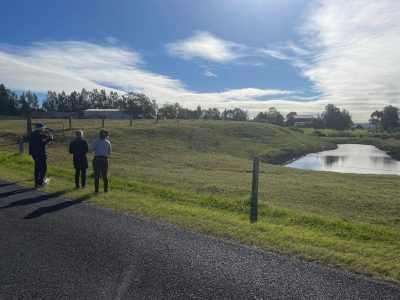Just 8km north of Maitland in the NSW Hunter Valley lies the small village of Largs. It is adjacent to the growing urban precinct of Bolwarra Heights, but its rural character remains intact with its cute corner pub and the striking Soldiers Memorial Hall. This hall was originally a School of Arts erected in 1878 as part of the movement to improve literacy amongst the largely dairy farming community. In 1921 it was tastefully added to in honour of those who served in World War 1. But for me the village has another less well-known claim to fame– it is the site of a Last Interglacial (Stage 5e) fossil bed.
In 1887, the Geological Surveyor by the name of Stonier discover a “raised beach” at Largs. This attracted the attention of Professor Edgeworth David who was busy mapping the geology of the lower Hunter region. He noted its abundant mollusc assemblage and provided a cross-section in a paper he published with R. Etheridge in Geological Survey of NSW, Record (2, 37-52). The site attracted further attention with collections made by C. Hedley in 1916, and later by T. Iredale who described 40 species in the Australian Zoologist in 1951 (v.11, 347-350).
During the course of my studies of the Quaternary of lower Hunter marine deposits in the early 1960s I became aware of David’s work. A chat about my interests with a teacher of geology at Scots College, Norm Pinwill, provided the exact location of the site at Largs. Many years before Norm had been taken there on a student excursion while at Sydney University. Here I was in 1962 at the same university searching for this so-called “raised beach”.
The Largs site stands out as a terrace abutting a bedrock ridge on which the village is situated. This terrace sits well above the Hunter flood plain. A small dam has been dug along its scarped base into sediments of the present-day flood plain (see image from May 2021 of the site located north of Goulburn Grove Road, Largs; Location map here). Shells outcrop within the terrace under a fluvial cap 4 to 5m thick. I was excited at the time to dig into the shell layers and obtain samples for dating. Was this a Holocene high sea-level deposit or was it older? A radiocarbon date of > 37000 years BP on an Anadara valve came back which was reported by Trevor Langford-Smith and me in our 1969 paper in the J. Geological Society of Australia (v.16, 572-580). The question then was whether we could get a more exact age.
It was not until the late 1980s that an opportunity presented itself to do more work on Largs material. By this time John Marshall and I had established an early Last Interglacial age using uranium-series disequilibrium technique on corals recovered from beneath Inner Barrier sands at Grahamstown to the east of Largs (Marshall and Thom, Nature, v. 263, 120-121). This technique was not appropriate for Largs shells. But something new had arrived: amino acid racemization! Fortunately at this time a specialist in AAR dating had also arrived: Colin Murray-Wallace. He was at Sydney University in The NWG Macintosh Centre for Quaternary Dating. It did not take me long to excite to Colin into dating Anadara samples from Largs. The next step was to describe the site in more detail.
In 1987 a class of geomorphology students on a Sydney University excursion were gently persuaded to do some digging. We were able to couple that with drilling involving my old driller mate, Karl Shaw. Results from this work are recorded in a joint paper by Colin and me in the Australian Journal of Earth Sciences (1988, v. 35, 571-574). We listed 27 shell species with Anadara trapezia dominating. One abraded Diprotodon bone was also found. Colin along with others that same year published dating results from here and elsewhere in Search (v. 19, 33-36). What was shown was a time equivalence of Largs ages with Grahamstown corals and other Last Interglacial marginal marine strata in southern Australia.
Colin and Tony Belperio put together a wonderful synthesis of U-series and AAR ages on corals and molluscs associated with the Last Interglacial marine event around Australia in a paper in Quaternary Science Reviews (1991, v. 10, 441-461). This review highlighted one startling fact, namely that north from Gippsland all the way the northern coast to the northwest WA (Cape Range) there is a marked paucity of LIG 5e sites above present sea level. The southern and western shores of the continent and Tasmania have many more datable sites. I have commented in another blog that the relative absence of LIG marine deposits lies in that half of the continent north of the “Sandiford Line” (Blog 141, 1/7/19 ). Colin and Tony highlight this in their Figure 7 (p.456). What does this tell us about the Largs site?
It is the one location where we can find LIG shell beds at an accessible location along the eastern and northern half of the continent. It is rich in molluscs and that assemblage informs us of conditions that prevailed during Stage 5e. Sea level along the central NSW coast at least was of the order of c.+4m. Indications from the species list here and the corals at Grahamstown suggest warmer marine waters. So Largs represents a geological site that tells as much as we can expect from fossil sites for the east coast at this critically warmer time of Earth’s history. It needs geoheritage recognition.
Bruce Thom
Words by Prof Bruce Thom. Please respect the author’s thoughts and reference appropriately: (c) ACS, 2021. For correspondence about this blog post please email austcoastsoc@gmail.com
#194


 PROPERTY RIGHTS: WHAT CONDITIONS PREVAIL IN A CIVIL SOCIETY?
PROPERTY RIGHTS: WHAT CONDITIONS PREVAIL IN A CIVIL SOCIETY?